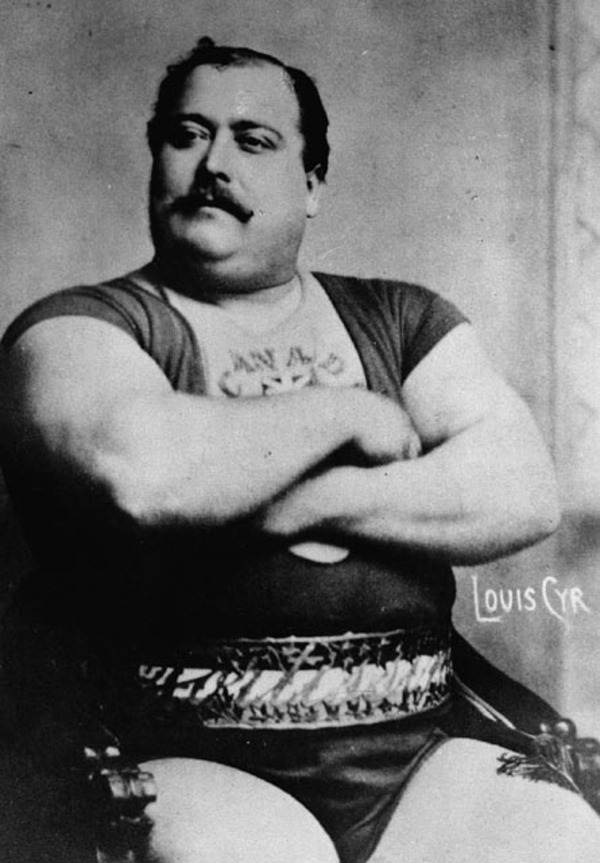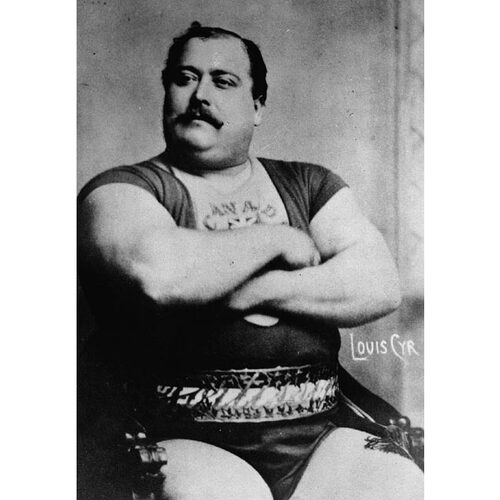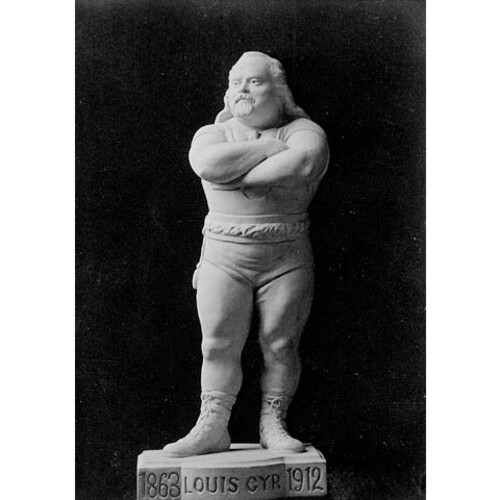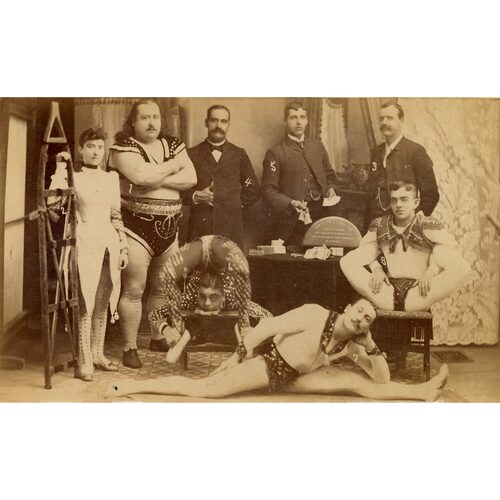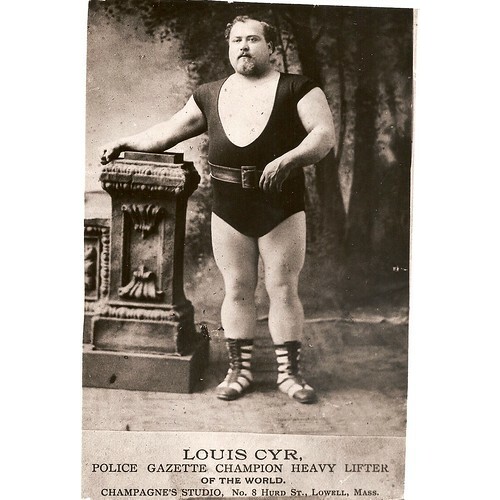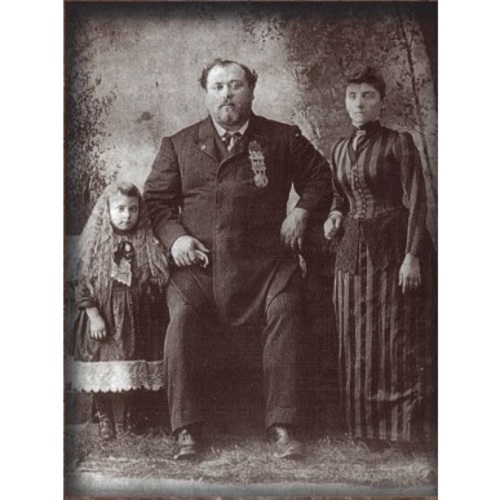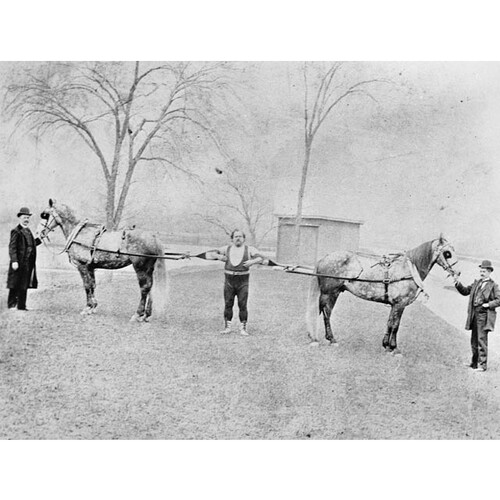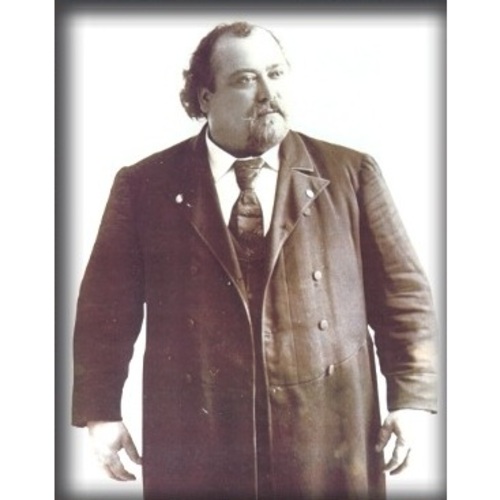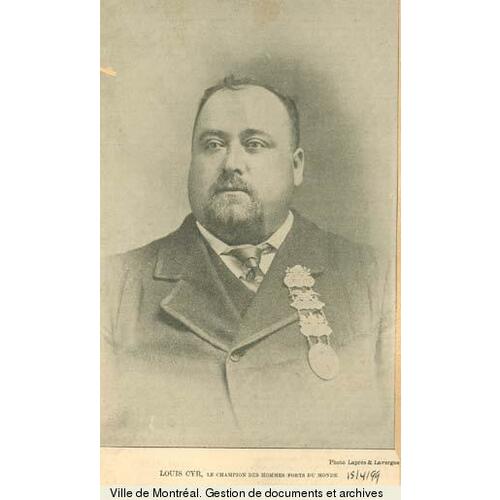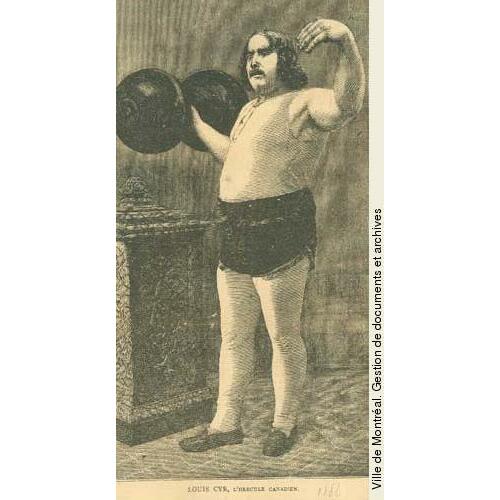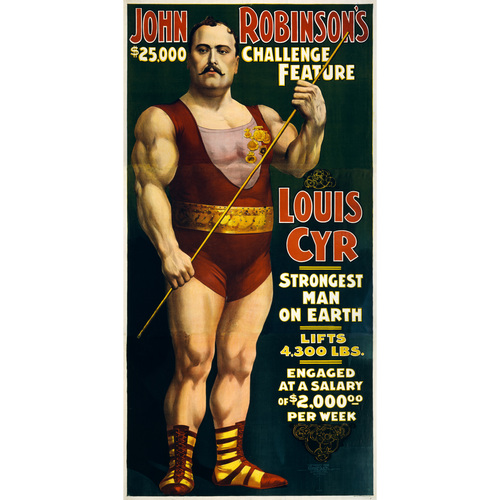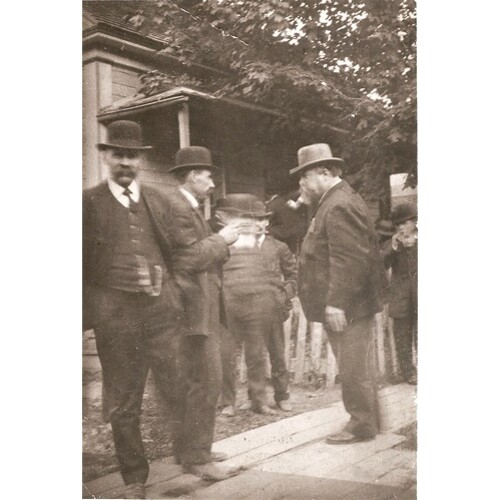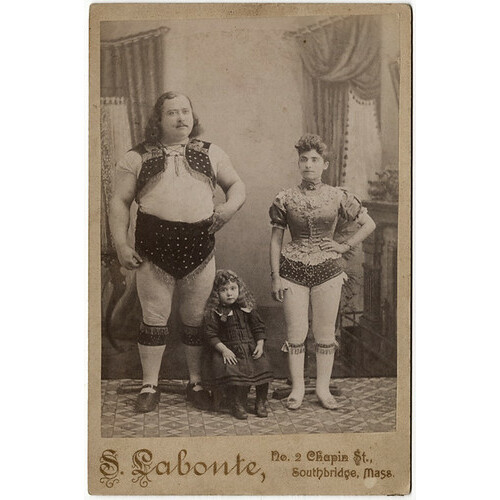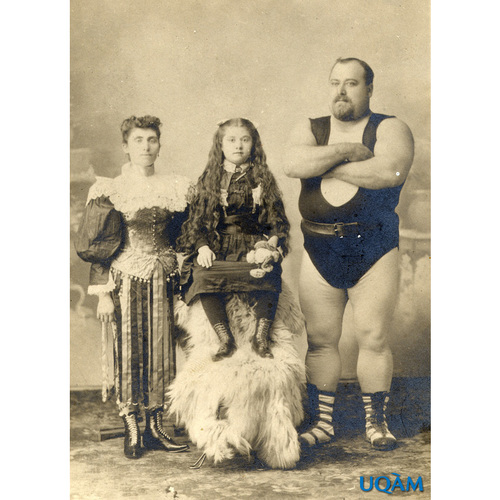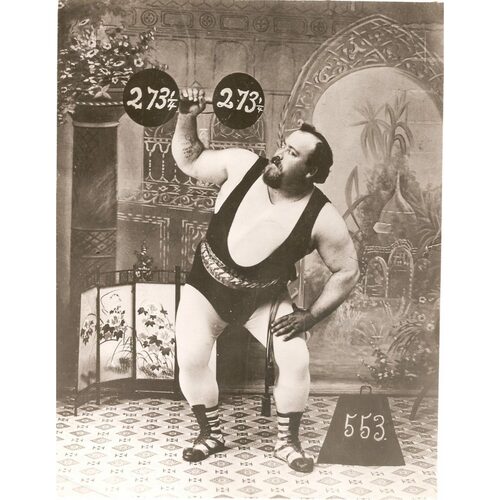CYR, LOUIS (baptized Cyprien-Noé, which he used until about 1880), farm-hand, lumberjack, weightlifter, policeman, and strong man; b. 10 Oct. 1863 in Saint-Cyprien (Napierville), Lower Canada, second of the 17 children of Pierre Cyr, a lumberjack and farmer, and Philomène Berger; m. 16 Jan. 1882 Mélina Comtois in Saint-Jean-de-Matha, Que., and they had a daughter, and a son who died in infancy; d. 10 Nov. 1912 in Montreal and was buried 14 November in Saint-Jean-de-Matha.
A quick-witted child, Cyprien-Noé Cyr was wilful yet gentle by nature. From early on he was endowed with exceptional strength, apparently inherited from his paternal grandfather Pierre Cyr, a coureur de bois, trapper, and hunter, but also from his mother, a woman of imposing stature and physical power. The young boy’s unusual ability soon attracted the admiration of his family, who were keenly interested in the strong men and feats of strength popular at the time.
After attending school in his village between the ages of 9 and 12, Cyr began working in a lumber camp in the winters and on the farm the rest of the year. In those places he performed his first feats of strength in public, impressing his fellow-workers with his prowess. According to one of his biographers, his mother then decided he should let his hair grow, like Samson in the Bible, and she herself curled it regularly.
In 1878 the Cyr family emigrated to the United States to seek their fortune and settled at Lowell, Mass. While living in Lowell, Cyprien-Noé changed his name to Louis, which was easier to pronounce in English. He worked in a textile mill, on a farm, in a machine shop, and at various other jobs. There, too, he soon became famous for his prodigious strength. At 17 he weighed some 230 pounds. He was carefree and chubby, and his pink cheeks and long blond curls gave him a babyish look that made him the butt of many jokes. He enjoyed playing the violin, dancing, working out with weights, and showing off his strength. When he was about 18 he entered his first contest of strong men in Boston and succeeded in lifting a horse off the ground. The big baby was then taken seriously and held in respect by the community.
In 1882 the Cyr family returned to the province of Quebec. Louis was married that year and went to work as a lumberjack. At the camp there was little in the way of entertainment, and his demonstrations of strength were among the most popular events. He undertook one feat after another, which soon became widely known for their unusual character. Hoping to improve his financial situation, Cyr moved back to Lowell with his wife in the spring of 1883. He was warmly received by Franco-Americans, who were already familiar with his exploits. A man named MacSohmer offered to organize a tour for him in the Maritime provinces and Quebec, where he would perform feats and challenge other strong men. It began in New Brunswick, but lasted only a few months. Cyr got nothing from it and had to part company with MacSohmer, who was a swindler.
Cyr then went to the Quebec village of Sainte-Hélène (Sainte-Hélène-de-Bagot), where his parents were living. He persuaded his family to organize a tour of shows in which he would present his own acts. His father took charge of it. The Troupe Cyr, as it was called at the time, gave performances throughout the province and met with tremendous success. A natural showman, Louis easily convinced the public that he fully deserved the title of strongest man in Canada.
In 1883 Cyr was offered a position involving less travel, as a policeman in Sainte-Cunégonde (Montreal). He held it until December 1885, and then went on tour again with a troupe of athletes recruited by Gustave Lambert, a Montreal wrestler, boxer, and weightlifter. In March 1886 he competed at Quebec with David Michaud, who was acknowledged as the strongest man in Canada. Cyr won an easy victory, lifting a 218-pound barbell with one hand (to Michaud’s 158 pounds) and a weight of 2,371 pounds on his back (to his opponent’s 2,071). The title of strongest man in the country now belonged to him.
Around 1888 Cyr bought a tavern on Rue Notre-Dame in Montreal, where he did a few feats of strength to amuse his customers. But he felt most at home on stage, and within a year he resumed touring with his own show, which included his wife and his brother Pierre. He travelled across Canada and the United States. In 1890 he joined an American troupe and he earned a growing reputation as the strongest man in the world. In the autumn of the following year he left for Europe, where he wanted to defend this title. He performed mainly in England, but the great champions did not dare challenge him and conceded him the title.
When Cyr returned to Canada in March 1892, he and strong man Horace Barré signed a one-year contract with the Ringling Brothers Circus of the United States. In 1894 the two men started their own circus, which had athletes, jugglers, acrobats, and strong men. It performed on Canadian and American stages for five years.
In 1900, however, Cyr’s health began to fail because of his weight, overeating, and inactive lifestyle. The onset of Bright’s disease put an early end to competitions and public displays of strength. He moved to a farm in Saint-Jean-de-Matha, where he received his friends and told stories of his triumphs; occasionally he took on competitors, such as Beaupré the giant [Édouard Beaupré*] in 1901, who wanted to claim the championship for themselves. The last of these was Hector Décarie, who in February 1906 met him in Montreal’s Parc Sohmer but could not strip him of his title. Well aware of his limitations and the precarious state of his health, Cyr used the occasion, however, to confer the honour on his young challenger.
Louis Cyr died at his daughter’s home in Montreal on 10 Nov. 1912 at the age of 49. The news appeared in the press the following day. Le Soleil and La Presse, among others, announced his death on the front page and, like Le Devoir and La Patrie, devoted several columns to an account of his life and exploits. According to Le Soleil, “His glorious athletic career . . . helped shed on [the French Canadian] race the lustre of a reputation for strength and uncommon physical vigour.” His contemporaries immortalized their hero with an impressive statue, now held by the Musée de la Civilisation at Quebec; it keeps alive in the province the memory of Louis Cyr, whose feats are still said to be unequalled.
In January 1908 Louis Cyr granted a series of interviews to a journalist from La Presse in which he recounted his life, his exploits, and his adventures. This account, originally published in La Presse, forms the basis of a book entitled Mémoires de l’homme le plus fort du monde (Montréal-Nord, Qué., 1980).
ANQ-M, CE1-19, 22 août 1885; CE5-30, 16 janv. 1882. Le Devoir, 11 nov. 1912. Montreal Daily Star, 19 March 1886. La Patrie, 11 nov. 1912, 29 mars 1970. La Presse, 11 nov. 1912. Le Soleil, 11 nov. 1912. Directory, Montreal, 1888/89. Martin Franklin, Louis Cyr, l’homme le plus fort du monde ([Montréal, 1946]). É.-Z. Massicotte, Athlètes canadiens-français; recueil des exploits de force, d’endurance, d’agilité, des athlètes et des sportsmen de notre race depuis le XVIIIe siècle; biographies, portraits, anecdotes, records (2e éd., Montreal, [1909]). Ben Weider, Les hommes forts du Québec (Montréal, 1973); Louis Cyr l’homme le plus fort du monde (2e éd., Outremont, Qué., 1993). S. F. Wise and Douglas Fisher, Canada’s sporting heroes (Don Mills [Toronto], 1974).
Cite This Article
Céline Cyr, “CYR, LOUIS (baptized Cyprien-Noë) (Cyprien-Noé),” in Dictionary of Canadian Biography, vol. 14, University of Toronto/Université Laval, 2003–, accessed March 30, 2025, https://www.biographi.ca/en/bio/cyr_louis_14E.html.
The citation above shows the format for footnotes and endnotes according to the Chicago manual of style (16th edition). Information to be used in other citation formats:
| Permalink: | https://www.biographi.ca/en/bio/cyr_louis_14E.html |
| Author of Article: | Céline Cyr |
| Title of Article: | CYR, LOUIS (baptized Cyprien-Noë) (Cyprien-Noé) |
| Publication Name: | Dictionary of Canadian Biography, vol. 14 |
| Publisher: | University of Toronto/Université Laval |
| Year of revision: | 1998 |
| Access Date: | March 30, 2025 |


